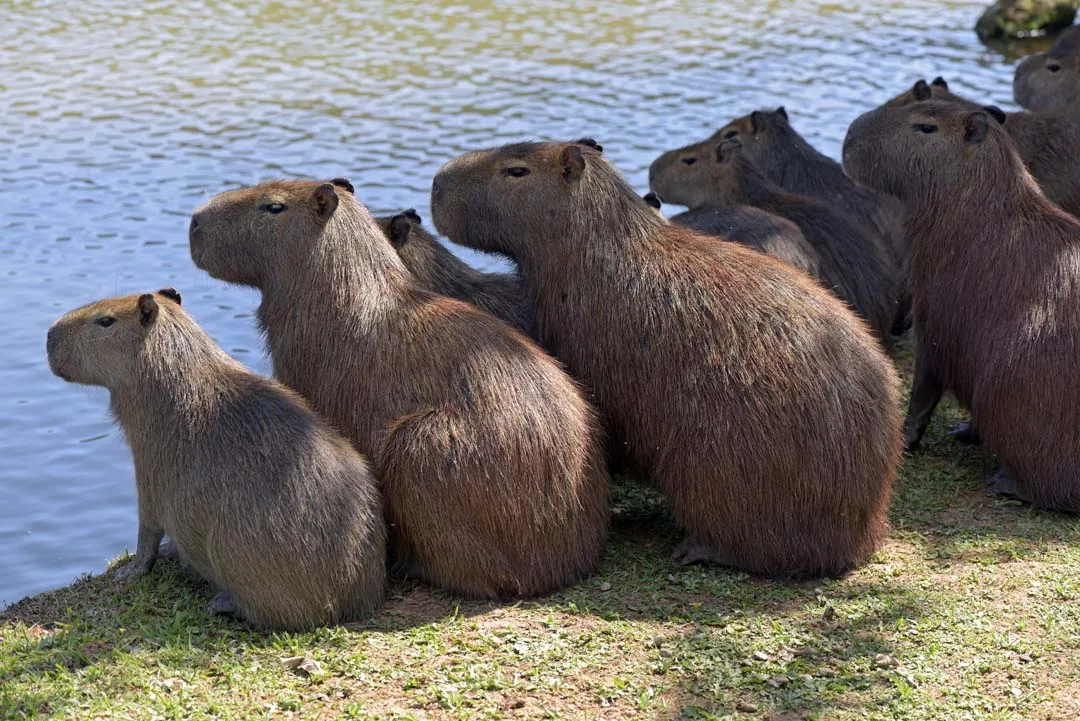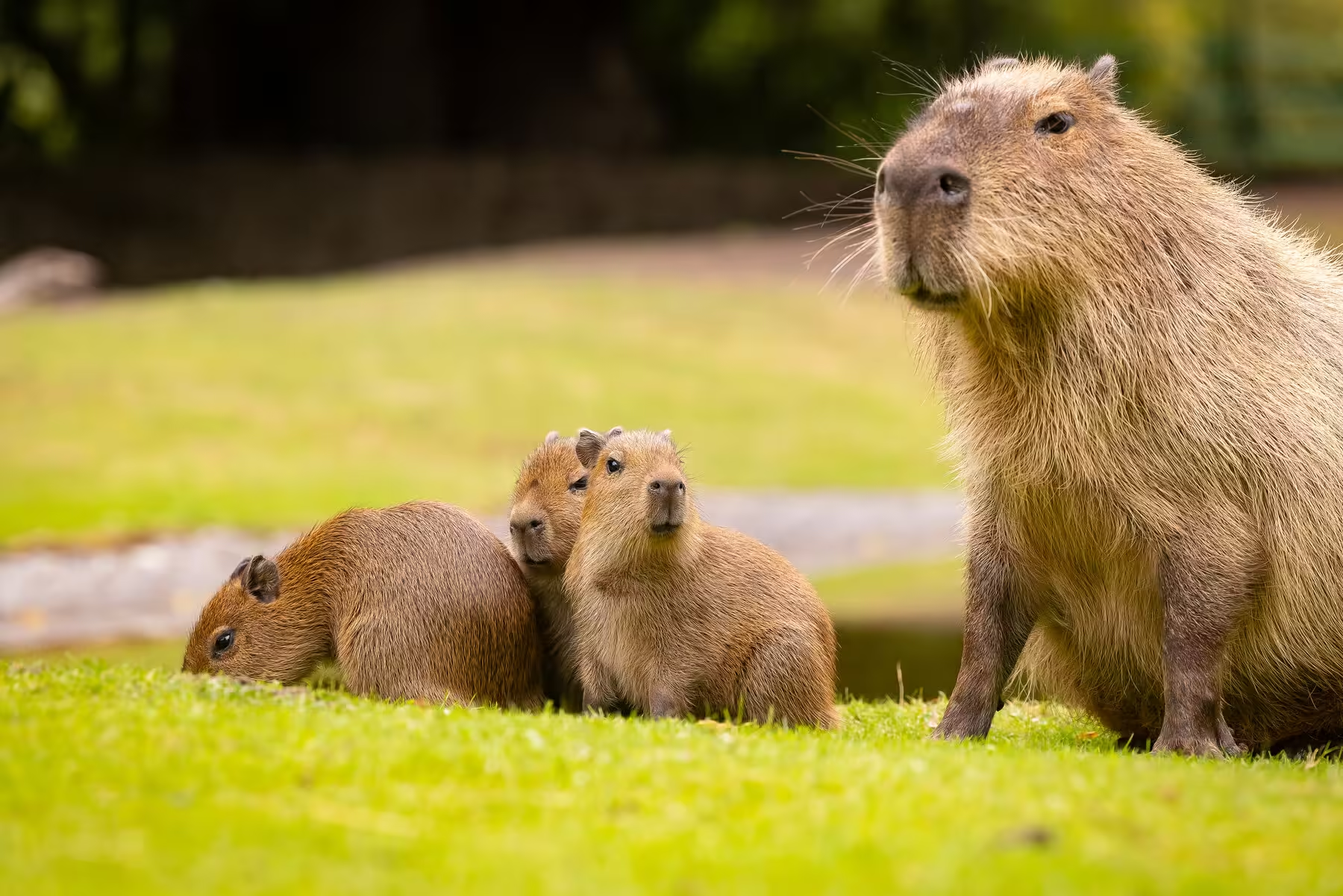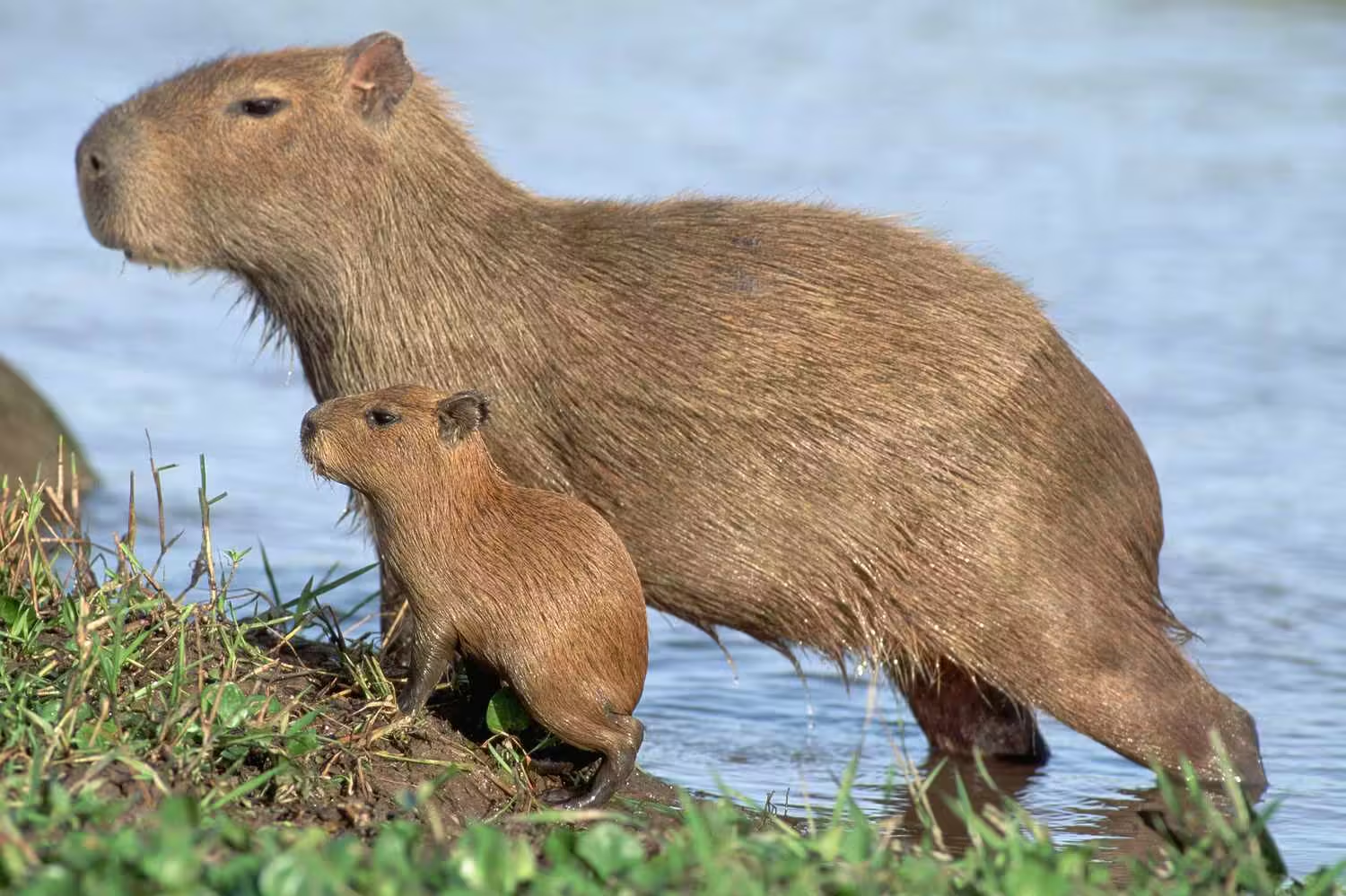Capybaras have interesting ways of living together in groups. So, what do we call a group of capybaras?
These animals love to live together, forming groups of 10-20. These groups have adult males, females, and young ones. When it’s dry, these groups can get really big, up to 50-100 members, all coming together near water.
There isn’t an official name for a group of capybaras, but people call them a “herd,” “colony,” or even a “meditation.” These names show how close these animals are to each other. They like to eat and even sleep together in big groups.
Key Takeaways
- Capybaras are highly social animals that typically live in groups of 10-20 individuals.
- During the dry season, capybara groups can grow even larger, reaching up to 50-100 members.
- There is no officially recognized collective noun for a group of capybaras, but terms like “herd,” “colony,” and “meditation” are commonly used.
- Capybara social groups reflect the close-knit nature of these rodents, who live, feed, and even nap together.
- Understanding the social structure and group dynamics of capybaras is crucial for their conservation and management.
Introduction to Capybaras
Overview of Capybaras
Capybaras are semi-aquatic rodents from South America. They are big and shaped like barrels. They belong to the Caviidae family, which also includes guinea pigs and rock cavies. Their fur is reddish-brown on top and yellowish-brown underneath. They are great swimmers and can hold their breath for up to 5 minutes.
Physical Characteristics of Capybaras
Adult capybaras can be as long as 106-134 cm (3.5-4.4 ft) and stand 50-62 cm (20-24 in) tall. They weigh between 35-66 kg (77-146 lbs), with females a bit heavier. The biggest wild capybara was a female from Brazil, weighing 91 kg (201 lbs).
They have webbed feet, short tails, and longer hind legs. These features help them live in the water.
| Characteristic | Measurement |
|---|---|
| Length | 39-51 inches (100-130 cm) |
| Height | 20 inches (50 cm) |
| Weight | 60-174 lbs (27-79 kg) |
| Group Size | Typically 10, up to 100 members |
| Home Range | 5-494 acres (2-200 hectares) |
| Activity Period | Dawn, dusk, or nocturnal when threatened |
What is a Family of Capybaras Called?
There isn’t an official name for a group of capybaras, but they live in social groups. These large rodents are very social and often live in groups of 10-20. In the dry season, these groups can get much bigger, sometimes having 50-100 capybaras around water sources.
Some people call a group of capybaras a “herd,” “colony,” or even a “meditation” because of their calm nature. The name “herd” fits well since they move and find food together in a coordinated way.
The capybara group or capybara colony is key to their survival and social life. Living together helps them protect themselves from predators, share resources, and take care of their young.
“Capybaras are the world’s largest rodents, and they are known for their social nature and their ability to thrive in a variety of habitats.”
Whether you call them a capybara herd, capybara pack, or a capybara colony, these creatures show how important cooperation and community are in the animal world.
Capybara Classification and Phylogeny
Capybaras are in the Hydrochoerus genus. This group has two living types: the capybara (Hydrochoerus hydrochaeris) and the lesser capybara (Hydrochoerus isthmius). They used to be in their own family, Hydrochoeridae. But now, studies show they belong to the Caviidae family with guinea pigs and rock cavies.
Capybara Taxonomy
The Hydrochoerus genus is in the Hydrochoerinae subfamily, along with rock cavies. In the Caviidae family, capybaras are near to the Kerodon genus. These two groups split from a common ancestor about 12 million years ago.
- The Hydrochoerus genus has two living species: the capybara (Hydrochoerus hydrochaeris) and the lesser capybara (Hydrochoerus isthmius)
- Capybaras are the biggest rodents alive, weighing 35 to 66 kg (77 to 146 lb) on average
- The lesser capybara is smaller, with a top weight of 28 kg (62 lb)
Fossil History of Capybaras
The fossil record shows capybaras and their relatives have a long history. Many extinct species have been found. Notable fossils include Cardiatherium, Phugatherium, Hydrochoeropsis, and Neochoerus. These are all true “capybaras,” not distant relatives.
“Capybaras and their extinct relatives were previously classified in their own family, Hydrochoeridae, but more recent molecular studies have placed them within the Caviidae family, alongside guinea pigs and rock cavies.”
Habitat and Distribution
The capybara, the largest rodent, lives in South America. It ranges from Panama to northern Argentina, skipping Chile. They love areas near water like lakes, rivers, and swamps. They also enjoy flooded savannas and the edges of tropical rainforests.
These rodents are great swimmers and use water to hide from predators. They’ve even been seen in places like Florida and the central coast of California. This is likely because some were released or escaped from captivity.
| Characteristic | Measure |
|---|---|
| Size | Head and body length ranges from 100 to 130 cm (3.3 to 4.3 ft), with shoulder height reaching up to 50 cm (1.6 ft). |
| Weight | Capybaras can weigh between 27 to 79 kg (59.5 to 174.2 lbs). |
| Gestation | The gestation period lasts up to 120 days, with an average of 3.5 young born per cycle, ranging from 1 to 7 offspring. |
| Habitat | Capybaras are found in habitats close to water such as marshes, estuaries, and along rivers and streams. |
| Population Density | In the Pantanal region, the density of capybaras is estimated at around 15 animals per hectare. |
| Life Span | Capybaras typically have a life span of 8 to 12 years. |
| Range | They are distributed east of the Andes in countries like Colombia, Venezuela, Ecuador, Peru, Brazil, Bolivia, Paraguay, Uruguay, and Argentina. |
The capybara (Hydrochoerus hydrochaeris) has two subspecies. Hydrochoeus hydrochaeris isthmius is smaller and lives in Panama, Venezuela, and Colombia. Hydrochoerus hydrochaeris hydrochaeris is larger and lives in South America.
“Capybaras can grow up to 1.30 m long and weigh 65 kg. The average weight is 50 kg in males and 61 kg in females, with a range between 27 and 65 kg.”
In the wild, capybaras live 8 to 10 years. Captive ones can live up to 12 years. They live in almost all of South America east of the Andes. This includes eastern Venezuela and Guyana to Uruguay, Paraguay, and northern Argentina.
Capybaras like living near lakes, rivers, and marshes. They prefer places with lots of vegetation for hiding. They can live up to 1300 meters above sea level and adapt to human-made changes in their habitat. They do well in areas turned into plantations or pastures.
Capybara Diet and Feeding Habits
Capybaras eat mainly grasses and aquatic plants. They are the biggest rodents in the world. They eat about 3-3.5 kg of plants every day.
Their eating habits change with the seasons. In winter and summer, they eat whatever they can find. But in spring and fall, they pick what they eat more carefully.
Capybara Food Sources
Researchers looked at 172 samples of capybara poop. They found 17 types of plants eaten by capybaras. Zizaniopsis bonariensis was a big part of their diet in winter, spring, and summer. In fall, Paspalum disthichum was their top choice.
In summer, capybaras eat more plants because the plants are better quality. They can eat a wide variety of plants because of their flexible eating habits.
Digestive Adaptations of Capybaras
Capybaras have special ways to digest tough plants. Their jaw moves in a special way to chew their food. They also have teeth that keep growing to replace old ones worn down by hard plants.
Capybaras eat their own poop to help digest tough plants. This is like how cows chew their cud. It helps them get more nutrients from their food.
“Capybaras are known to regurgitate their food and chew it again, similar to the cud-chewing process of cattle, further aiding in the digestion of their fibrous diet.”
Social Structure and Behavior
Capybaras live in groups of about 10-20, mixing adults and young. In the dry season, these groups can grow to 50-100 capybaras, all coming together near water.
Group Dynamics of Capybaras
Adult males in capybara groups form bonds and decide who’s in charge. They often have 4-14 females in their group. These groups are denser than similar-sized animals in the tropics.
With more males, they can get aggressive. They chase and harass each other a lot.
Communication and Scent Marking
Capybaras bark like dogs when they feel threatened or when they’re moving their young. They have scent glands on their snout and behind. Males use these glands a lot more than females.
They mark their territory with scent. Males do this a lot, especially in the wet season. Females also mark, especially when they’re ready to have babies. They can make a sound through their nose to signal this to males.
They spread their scent by urinating, but females often mark without it. This helps them communicate with each other.
| Capybara Social Dynamics | Key Characteristics |
|---|---|
| Group Size | Typically 10-20 individuals, but can reach up to 50-100 during the dry season |
| Group Composition | Mix of adult males, adult females, and juveniles |
| Dominance Hierarchy | Strictly linear, determined by stereotyped agonistic interactions |
| Mating System | Dominant males have a harem of 4-14 females |
| Scent Marking | Both males and females use scent glands for communication, with males marking more frequently |
| Vocalizations | Barks, whistles, purrs, and grunts used for communication |
Capybaras have a complex social life, living in groups and communicating in special ways. They use scent and sounds to talk to each other. These skills help them live well in their wet and dry homes, keeping their groups strong.
Reproduction and Breeding
Capybaras have unique courtship and mating rituals. When a female capybara is ready to mate, her scent changes. This signals nearby males. She also whistles through her nose to show she’s ready.
But, they only mate in the water. If a female doesn’t want to mate with a male, she can either dive or leave the water.
Even though males lead the group, they can’t stop all subordinate males from mating. This shows how complex capybara society is. Dominant males protect the females in their group.
Gestation and Birth
The gestation period for a female capybara is 130-150 days. She then gives birth to a litter of 3-8 young, called capybarapups or capybarabies. These babies are precocial, meaning they’re born with their eyes open and can swim soon after.
Capybaras can live up to 8-10 years, but in the wild, they usually don’t make it past 4 years. This is because of predators.
“Capybaras only mate in the water, and if a female does not want to mate with a particular male, she can either submerge or leave the water.”
Predators and Lifespan
Capybaras, the world’s largest rodents, face many dangers in South America. Powerful predators like jaguars, pumas, green anacondas, and caimans hunt them. Even eagles go after young or weak capybaras.
These threats cut short their lives. In the wild, most capybaras don’t live past 4 years. Only a few lucky ones make it to 8-10 years. Captive capybaras, however, can live up to 12 years, almost twice as long as those in the wild.
But capybaras face dangers beyond just predators. Losing their homes and diseases also kill many. They are key to their ecosystems, so keeping them safe is vital. This helps keep the balance in South America’s wetlands and forests.
| Capybara Lifespan | Wild | Captivity |
|---|---|---|
| Average Lifespan | 4 years | 12 years |
| Maximum Recorded Lifespan | 8-10 years | 12 years |
Capybaras are threatened by many predators, including:
- Jaguars
- Pumas
- Eagles
- Caimans
- Green Anacondas
But it’s not just predators that are a problem. Capybara mortality is also affected by diseases and losing their homes. Their ability to survive is a sign of their strong adaptation and resilience.
“Capybaras are truly remarkable creatures, capable of thriving in the face of so many threats. Their story is a testament to the incredible diversity and resilience of life on our planet.”
Conservation Status and Threats
The capybara, the biggest rodent, is listed as Least Concern by the IUCN. It’s found all over South America and has big, stable populations. But its relative, the lesser capybara, is Near Threatened because it has a smaller range and its home is broken up.
Capybaras face threats that could affect their numbers. One big threat is losing their home due to deforestation and cities growing. As people move in, capybaras lose the places they need to live and find food.
Another threat is hunting for their meat and skin. This isn’t a big problem now, but could be if we don’t manage hunting well.
Despite these problems, capybaras are very resilient and adaptable. In some places, they even do well in cattle ranches, finding food and shelter there. This ability to adapt helps keep their numbers stable, but we still need to watch over them to make sure they keep thriving.
| Threat | Impact | Conservation Measures |
|---|---|---|
| Habitat Loss | Deforestation and cities have cut down the capybara’s home, leaving them with less space. | Using land wisely, protecting their homes, and fixing damaged areas. |
| Hunting | Capybaras are hunted for their meat and skin, which could get worse if not controlled. | Setting rules for hunting, offering other jobs, and teaching people why capybaras matter. |
| Climate Change | Changes in the weather and extreme events could harm their homes and food. | Studying how climate change affects capybaras and finding ways to adapt. |
We can help the capybara by tackling these threats and taking action to protect it. This species is crucial for South America’s ecosystem.
“Capybaras are a true ecological ambassador, reminding us of the interconnectedness of all life on our planet. Their conservation is not just about protecting a single species, but about safeguarding the entire web of life that sustains us all.”
Capybaras in Captivity and as Pets
Capybaras are sometimes kept in captivity, in both zoos and homes. They are large, semiaquatic rodents that need special care to do well. It’s important to think carefully before deciding to keep them as pets.
These animals can weigh up to 175 pounds. They need a lot of space and water for swimming. They also do best in groups, not alone. So, owners must have a big, well-made enclosure and a fun environment for them.
It’s possible to tame capybaras a bit, but they are strong and need to be handled with care. Before getting one as a pet, you should really think about the challenges and duties of caring for them. Taking good care of them is key for their health and the safety of their owners.
| Captive Capybara Requirements | Considerations for Capybara Owners |
|---|---|
|
|
Thinking about getting a capybara as a pet might be exciting, but it’s vital to do your homework first. Understand their unique needs and challenges before deciding to keep them in captivity. Being a responsible owner and taking good care of them is essential for their happiness.
Capybaras are the biggest rodents in the world, fascinating people everywhere. They live in South America’s wetlands and forests. They are known for being calm, having strong social ties, and adapting well to their homes.
These creatures can grow up to two feet tall and weigh as much as 170 pounds. They eat a lot, up to 8 pounds of grass each day. This shows how amazing nature can be. They live in big groups, sometimes with up to 40 members, showing how important community is to them.
Even though capybaras are not in danger, they still face threats like losing their homes and being hunted illegally. It’s important to learn more about them and protect their homes. This way, we can make sure they are around for future generations to enjoy and learn from.



